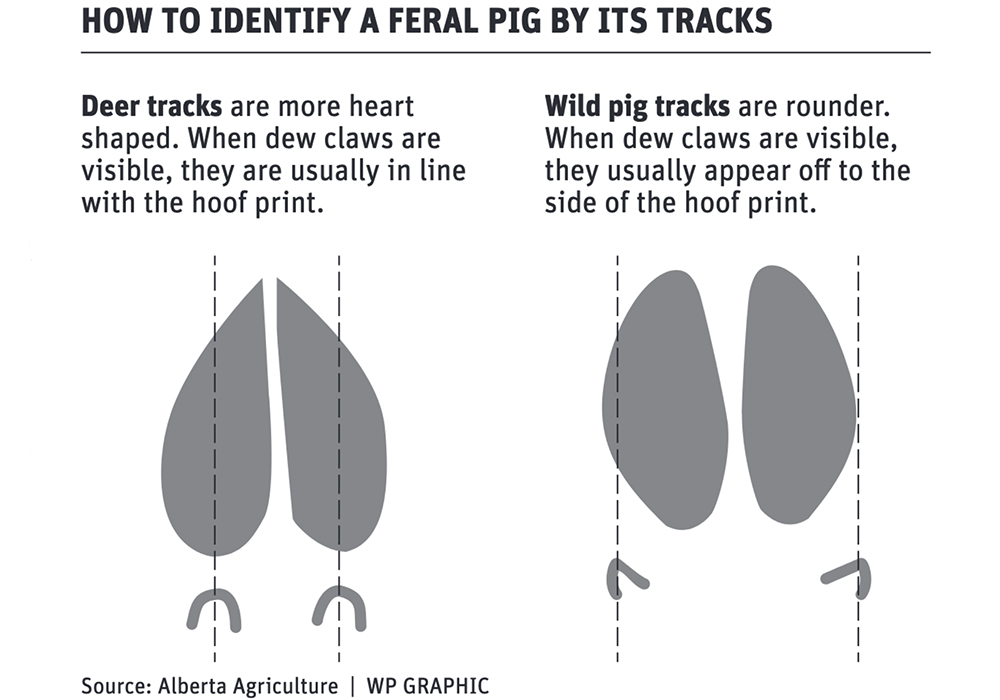Sturdy, corral-type of enclosure using five-foot-high panels found most effective way to capture and eliminate a sounder
Recommendations are in the works regarding control of Alberta’s feral pig population.
Alberta Agriculture and Parks personnel have recently completed a three-year pilot project designed to figure out the scope of the problem, educate the public about the invasive pests and test different means of surveillance and capture.
That project will result in eradication recommendations.
The feral hogs, an invasive species designated as a pest in Alberta, damage property, crops and feed, and also create troublesome wallows for landowners.
Perry Abramenko, pest specialist with Alberta Agriculture and Parks, said a system involving a sturdy enclosure with remote-controlled gate has proven effective in trapping groups of pigs, called sounders, so they can be killed.
Read Also

Farming Smarter receives financial boost from Alberta government for potato research
Farming Smarter near Lethbridge got a boost to its research equipment, thanks to the Alberta government’s increase in funding for research associations.
Portable traps that catch only one or two pigs at a time serve only to educate the other animals in the sounder to avoid similar traps.
“We want to eradicate, not educate the ones that get away,” Abramenko told a recent webinar organized by the Alberta Invasive Species Council.
Control of the feral pigs has garnered more attention in recent years due to fears the animals could spread African swine fever if it ever arrived in Canada, as well as other porcine illnesses. Though disease can be managed in contained domestic pig operations through treatment and culling, there are no similar checks on wild pigs.
Abramenko said all feral pigs eradicated by his department are checked for disease and so far no viruses, bacteria or parasites have been found. However, the threat is real considering that feral hogs have been proven through DNA testing to have various domestic pig genetics.
Numbers are unknown and hard to estimate because not everyone reports sightings, Abramenko said. Sometimes their tracks are confused with those of deer so damage is attributed to other species.
As well, there is no compensation available for property damage from the pigs so farmers may not think it worthwhile to report.
However, the pigs have been found in 24 rural municipalities within Alberta and seem to be most populous in Lac St. Anne and Woodlands, northwest of Edmonton. The department has a trapper on contract who is focusing his attentions in those regions, Abramenko said, but can be called on to address problems in other regions if necessary.
He estimated that there are hundreds if not thousands of feral pigs in the province.
The department has found that the most effective way of capturing and eliminating a sounder is to erect a sturdy, corral-type of enclosure using five-foot-high panels. Bait is placed in the enclosure for a time so the feral pigs get comfortable entering.
Technology allows the eradication team to view the pigs on mobile phones when the system sends an alert of the pigs’ presence. When the team is confident an entire sounder is inside, they activate a remote-controlled gate to capture the pigs.
The process can take several weeks, depending on the size of the sounder and the wiliness of the pigs.
Hunting has not proven effective in reducing numbers, said Abramenko.
“Nowhere has hunting had any positive impact … on controlling wild pig populations. Hunting actually makes the problem worse,” he said.
“It’s a tough message and a lot of people don’t want to hear it because they value these animals. There’s no season, there’s no limits. Some people like to eat them, but hunting really has no place in eradicating wild pigs and so as a consequence of that we totally discourage people from hunting wild boar.”
Hunting tends to disperse the pigs and encourages them to do their damage at night.
Farmers who spot the animals or sustain damage should report it to the department at A.F.wildboar@gov.ab.ca, an email address that Abramenko said would be activated shortly.
The states of New York and Colorado have successfully eradicated feral pigs so it is possible for Alberta, albeit a major challenge.
Complicating matters is that there are 13 wild boar operations in the province. Though they are subject to specific standards on fencing and containment and are inspected at least once a year, escapes can sometimes occur.
“These animals are very motivated to escape,” said Abramenko.
Many counties and municipal districts have banned wild boar operations as a result of the problems that escapees can create.
Drones and sniffer dogs have been used at various times to find sounders or determine if they’ve been present. As well, DNA analysis of water bodies where pig presence is suspected has proven effective in verification.


















